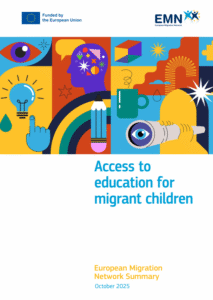An inform on access to education for migrant children is now public
07.11.2025Education is central to fostering shared values, promoting inclusion and to offering children, regardless of their migration background or socioeconomic status, an opportunity for social mobility. Early and effective access to inclusive, formal education is one of the most important and powerful tools for integrating children. Learners from disadvantaged backgrounds, including migrant children, are overrepresented among underachievers and are more likely to leave education and training without an upper secondary qualification.
Acknowledging the importance of ensuring effective access to education for migrant children, this AHQ summary gives an overview of the situation of migrant children in primary and secondary schools across EMN Member and Observer Countries.
Key findings:
- Twenty-four EMN Member Countries and Serbia provide support measures at national level to help migrant children to adapt to the different cultural environment in primary and secondary school, although not all offers are exclusively designed for migrant children but rather available to children in need overall, both local and migrant children. The most common measure is support to learn the local language(s). Thirteen responding Countries provide psychosocial support to help migrant children to adjust to a different educational environment. In addition, mentors can be assigned to help migrant children to navigate the school environment.
- The majority of responding EMN Member Countries and Serbia have implemented targeted measures to enhance the intercultural and psychosocial competencies of teachers to support migrant children to adapt to different cultural environments in primary and secondary schools.
- Only Finland, Luxembourg and Spain monitor the level of academic performance of migrant children compared to other children at national level.
- Almost all respondent Countries experience challenges to provide effective inclusive education to migrant children. The most common challenge is a language barrier. Another frequent challenge is differences in the education system of the host country and the country of origin, for example teaching methodologies and assessment criteria.
- Generally, the good practices identified by responding countries mostly relate to measures to counteract the challenges described above.
You can download the inform here.
